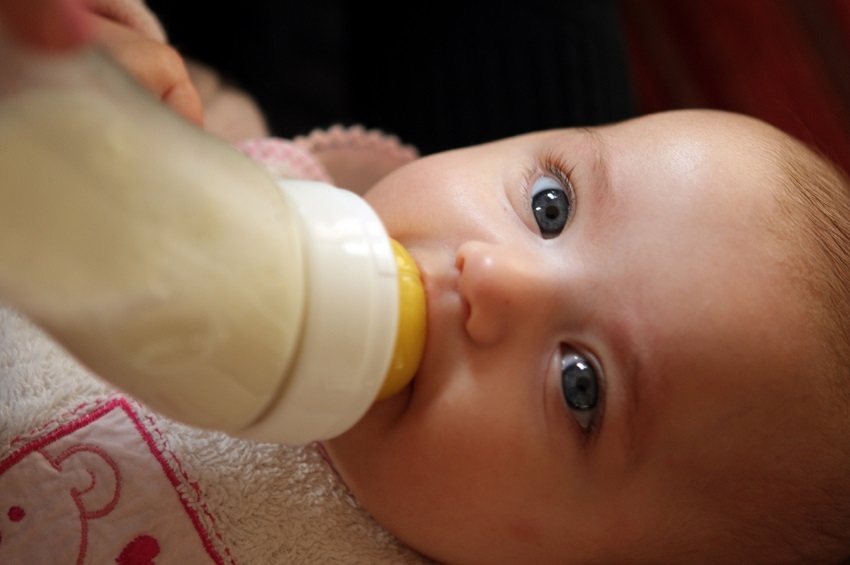Feeding your baby
Feeding your baby in the first year of life is an exciting adventure for parents and babies alike. It's about development, nutrition, exploration, sharing and learning. You can help your baby develop a lifetime of healthy eating habits with the right start.
The first 6 months
For the first 6 months of life, breastfed babies will get what they need from their mother's milk.
Breast milk has the right amount and quality of nutrients to suit your baby's first food needs. It is easiest on her digestive system, so there's less chance of constipation or diarrhea. Breast milk also contains antibodies and other immune factors that help your baby prevent and fight off illness better.
Babies who are exclusively breastfed should get a daily supplement of vitamin D, which is available as drops.
If breastfeeding is not an option, use a store-bought iron-fortified infant formula for the first 9 to 12 months. The formula should be cow's milk-based.
Introducing solid foods
At 6 months, most babies cannot get everything they need from breast milk or formula alone. Though you can continue to breastfeed until your baby is 2 years and beyond, at 6 months you'll start to introduce your baby to other foods. Your baby is ready to start other foods when he:
- Seems hungry earlier than usual
- Can sit up without support, and has good control of his neck muscles
- Holds food in his mouth without pushing it out on his tongue right away
- Shows interest in food when others are eating, and opens his mouth when he sees food coming his way
- Can let you know he doesn't want food by leaning back or turning his head away.
There are many ways to introduce solid food. The first foods usually vary from culture to culture and from family to family.
Breast is best!
There are many advantages to breastfeeding your baby. It's easy. The milk is always available to the baby. The mother doesn't have to worry about heating a bottle when her baby is ready to eat. She doesn't have to worry about keeping breast milk warm or cold when going out. And best of all, a mother can feed her baby in bed at night, allowing her to get as much rest as possible.

It's very good for your baby
- Breast milk has antibodies in it that pass from the mother to the baby and help protect him against illness and allergies.
- Breast milk is easily digested.
- Mothers don't have to worry about their babies being constipated or thirsty, because babies get an adequate amount of water from breast milk.
- Sucking at the breast helps with good oral development.
- Breastfed babies have fewer speech impediments.
- Breastfed babies have good cheekbone development and jaw alignment. Consequently, there is less chance of needing braces and other orthodontial work.
It's also good for you
- The baby's sucking at the breast causes uterine contractions right after birth. The contractions lead to less bleeding for the mother, and return the uterus to its pre-pregnancy shape much faster. Breastfeeding burns calories. A mother can lose much of her pregnancy weight faster than if she were bottle-feeding her baby. It also creates a bond between mother and baby, helping the mother learn her baby's cues and signals faster. This makes mothering her baby easier.
Baby's first year
The American Academy of Pediatrics currently recommends breastfeeding for at least the baby's first year. As solids are introduced (usually around the middle of that year) the baby will shift his primary source of nutrition from his mother's milk to other foods. Basically, you feed your baby as long as you and your baby wish to continue.
All the contributions of human milk, both nutritional and health, continue for as long as a baby receives breast milk. In fact, as the baby takes less breast milk, these benefits are condensed into what milk is produced. Many of the health advantages of breast milk are dose related: the longer the baby receives breast milk, the greater are the benefits.
- The baby nurses frequently averaging at least 8-12 feedings per 24-hour period.
- The baby is allowed to determine the length of the feeding, which may be 10 to 20 minutes per breast or longer.
- Baby's swallowing sounds are audible as he is breastfeeding.
- The baby should gain at least 4-7 ounces per week after the fourth day of life.
- The baby will be alert and active, appear healthy, have good color, firm skin, and will be growing in length and head
Good for you, Good for your baby
The physical act of breastfeeding is more than the quantity of milk that is supplied, as you will find once you hold your baby in your arms. Breastfeeding is warmth, nutrition, and mother's love all rolled into one. Understanding and appreciating the signs of knowing when your baby is getting enough to eat is one of the most important things a new mother can know.
Bottle Feeding your baby
Here are some tips to make bottle feeding easier, more trouble-free and more rewarding for you and your baby:
- Soothing Mood. Feeding your baby is an important comforting and bonding time. Get comfortable, and hold the baby so that the two of you can look at each other. Hold your infant securely, but not tightly.
- Pay attention to temperature. Babies have individual tastes: Some like their bottles the same temperature every day, and some don't care if you feed them warmed formula one day and chilled formula the next. If yours fusses when the temperature varies, keep it constant.
- Keep formula consistent. Mix your formula precisely the same way every time. Never dilute the formula any more than recommended on the label, because your child will end up being shortchanged of necessary nutrients.
- Boil new nipples. Brand-new nipples can have a plastic taste that your baby may not like. To get rid of that new taste, boil the nipple in water before using it.
- Consider the hole. It's important that the size of the hole in the nipple is neither too big nor too small. If it's too large, formula will pour through too quickly and your baby may choke, and if it's too small, your baby may become frustrated trying to get enough formula. Check hole size by turning the bottle upside down and watching the formula drip out. If it comes out in a stream, buy nipples with smaller size openings. If formula won't come out until you squeeze the bottle, buy nipples with larger holes or make the hole bigger.
- Hold on to the bottle. A parent with a million things to do may want to prop up the bottle so the baby can eat on her own. But babies need the cuddling and closeness that's a part of feeding. Also, a baby left alone with a bottle can choke if milk runs down her throat and when a baby lies flat on her back to drink, milk may come back up into her throat possibly causing an earache or ear infection.
- Get the right tilt. Start holding your baby's bottle at a 45-degree angle, and raise the end as the baby feeds. Watch the neck of the bottle and keep it tilted so you don't get an air bubble.
- Alter positions. If your baby tends to spit up more than once during feedings, a change of position may help. You need to try out various angles until you find one that agrees with your baby. The best position depends on each baby's esophagus and gastrointestinal tract.
- Go with the flow. Don't expect your child to drink a full bottle at noon today just because she took a full bottle at noon yesterday. Appetite varies from day to day.
- You also shouldn't live by the clock. If it's a half hour before your baby's usual eating time, and he's fussing and seems hungry, feed him. Or if he naps past his usual feeding time, let him sleep and feed him when he awakens.
- Clue in to the signals. Your baby should be the one to decide how much he eats. When a baby stops sucking vigorously or starts squirming or looking around the room, that should signal the end of the feeding. Never urge the rest of a bottle on a child who doesn't want it. It's better to throw formula out than to have your baby overeat.

Feeding your baby solids
The American Academy of Pediatrics says, "babies don't need other foods in their diet until somewhere in the middle of the first year of life." This statement is very useful, because it doesn't say your baby needs other food at some specific age. You can let your baby be your guide. And babies will tell you when they are ready for solids, somewhere between 6 and 12 months. Like breastfeeding: "watch the baby, not the clock." Prior to that time, an infant's digestive system is not mature enough to digest foods other than human milk adequately.
Watch out for these signs
- Increased nursing that continues for more than a few days and is unrelated to illness or teething;
- Increased interest in table food while others are eating;
- The ability to sit up; absence of the tongue-thrusting reflex so that baby does not push solids out of his mouth;
- And an ability to pick up food and put it in his mouth.
You may notice that your baby may think he/she is ready for solids, may be grabbing food off your plate, and enjoying the new taste. But later in the day, the baby may have an upset tummy, become constipated, or you may see the food come out in the diaper, in the same form as when it went in, completely undigested. Your milk remains the perfect nutritious food for your baby, until his system is ready for table foods.
If you've started solids, you can stop, and try again a few weeks later. Also keep in mind that four months is the bare minimum age at which your baby might be ready for a taste of solid food. It's much more common for a baby to be ready for solids later in his first year. If you are a first time mother, you may be eager to try it.

Offer breast milk as well
When your baby does start solids, remember to breastfeed first and then offer solids. Your baby doesn't need big quantities, a teaspoon or so. Other foods still aren't as good as breast milk during the first year; you're just trying to get baby used to other tastes and textures. Mashed banana is an easy food to start with; babies almost always like it. Protein foods come early in the rotation, mashed pieces of meat. Eggs should wait a little while.
When you start feeding your baby solids, introduce only one new food at a time, and wait a week before trying each new food. This way you can watch for any signs of allergic reaction (such as rashes, hives, wheezing or diarrhea). If you have a family history of allergies, you need to be especially cautious.
Foods that are commonly allergenic include cow's milk, eggs (especially the whites), citrus fruits, peanuts, wheat, and corn.
